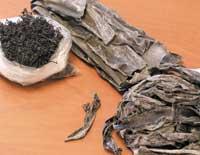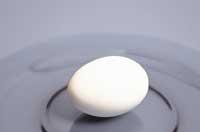Algae algae algae
Algae of various colors and shapes are known. For example, spirulina is very small (millimeter) and blue, while laminaria measures about two and a half meters and is green; fucus is similar to lettuce sheet, but darker; wing or grain and salmon, by their form, are also called marine spaghetti; red algae are used to produce additional agar-agar (this additive is used as thickener and emulator).

In Western countries there is no custom of using algae as food. However, some scientists consider it a good opportunity to solve the hunger suffered by an important part of humanity. And it is that three quarters of the Earth is water, so the controlled cultivation of these plants is relatively easy and, in addition, they are the most autonomous vegetables, since they do not need irrigation, fertilizers and pesticides. In addition, they have many nutritional properties, including:
- Carbohydrates: most cannot be digested (gum and mucilage), so they are very effective as laxatives or laxatives.
- Fat: they do not have fat.
- Proteins: Proteins: In general, fresh algae have very little protein (1.68 mg/100 g) and their quality is low. The only exception is spirulina, since once dry, 70% of its ingredients are good quality proteins.
- Sodium: Sodium: 100-300 mg/100 g. Because of its large amount, CARE if you have hypertension problems, in this case you should not take algars.
- Calcium: calcium: calcium: calcium 168 mg/100 g. One hundred ml of milk contains 114 mg.
- Iron: Iron: Most fresh algae contain between 2,5 and -3 mg of iron per 100 g, as well as red meats, sometimes more.
- Magnesium: Magnesium: 121 mg/100 g. Something more than a third of what we need every day.
- Iodine: Iodine: Of all foods, algae are the most abundant source of iodine. Dried laminated seaweed has 62,400 g of iodine per 100 g, a thousand times more iodine than an adult needs every day. Fish is also a good source of iodine, but it has between 150 and 300 mg of iodine per 100 g. Therefore, algae are highly recommended in case of goiter and hypothyroidism. For the same reason, people with hyperthyroidism cannot eat laughter.
- Vitamins: Vitamins: Vitamins: They contain adequate amounts of B1, B2, E and niacin, plus 180 g of folic acid per 100 g. It needs almost one adult a day (200 g) and half (400 g) of what the pregnant woman needs. They contain folic acid and iron, so the algae are recommended in case of anemia.
The algae cook for 20-30 minutes and are added to the rice, pasta and legumes like any other vegetables. They can also be prepared in tortilla, fried and empanadas. There are as many options as you want. Yes, it uses very small amounts. In fact, they are usually sold by dehydration and acquire a large volume during cooking. Do not give salt when cooking, as they are abundant.
Be careful with problems of hypertension or hyperthyroidism as indicated above. If not, they can be taken calm and are a good opportunity to make some changes in the diet and enjoy the new flavors.
Iodine iodine
Our body contains approximately 20-30 mg of iodine, of which 75% corresponds to the thyroid gland. The remaining 25% is distributed throughout the body, especially in the gastric mucosa and blood.

Most of the iodine accumulates, therefore, in the thyroid gland, where it participates in the production of triidothyronine (T3) and thyroxine (T4). These hormones participate, among other things, in the regulation of metabolism. If the iodine in our body is at an adequate level, the production of these hormones will be adequate and the metabolism will be well regulated. However, if we have less iodine than necessary, we will produce fewer hormones than necessary, which is called hypothyroidism. All bodily reactions of hypothyroidism occur very slowly and slowly, energy consumption is very low and often overweight. At the same time, an excess of iodine in the body produces excessive hormones and accelerates body processes, consumes more energy and thinns. This is due to hyperthyroidism.
In order to properly perform the functions of thyroid hormones, all adolescents and adults should take 150 mg of iodine each day. Pregnant or lactating women need between 25 and 50 mg more, while newborn children need 40 mg up to six months, 50 mg up to the year and from that year an average of 70-120 mg daily.
Drinking water and food contain very different amounts of iodine. The food with more iodine is the algae. Then you will find the saltwater fish and seafood (mussels, clams...). These contain between 300 and 3,000 mg/kg and fresh water between 20 and 40 mg/kg. The amount of iodine of meat, eggs and dairy products depends on the type of feed of the animal. If these animals are supplied with high-iodine feed, their meat, eggs and dairy products will also be rich in iodine. However, they are not really very abundant sources of iodine.
As for vegetables and fruits, those that are sown by the sea have much more iodine than those of the interior, since these lands, as well as the water used for irrigation, have more iodine.

The very serious lack of iodine causes in some underdeveloped countries a disease called goiter. As a result of this disease, the thyroid gland of the neck expands enormously trying to get the scarce iodine in the body. If the pregnant woman suffers from this serious lack of iodine, the baby about to be born can suffer a cretinism: interruption of physical and mental development, hypothyroidism, low height...
In developed countries, there is usually no such serious shortage, but children who have iodine below the necessary level have been found. For this reason, a few years ago the sanitary managers decided to add iodine to salt and today we can find iodated salt in any store. With this salt just cook to have no shortages.
But be careful: excess iodine for a long time can have the same effect of deficiency, that is, it can cause goiter (even if it is very slow). However, do not worry too much, since the current problem is not exaggerated and is not consuming too much iodine every day due to the moderation of iodate salt.





